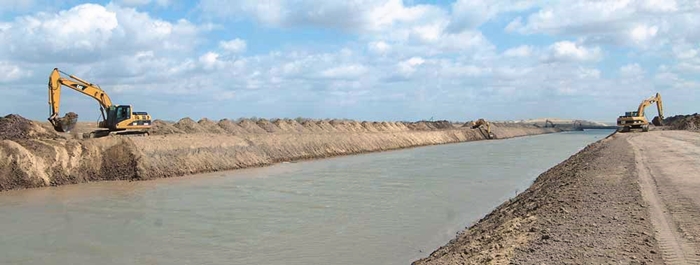Across Turkmenistan, dedicated work is underway to maintain irrigation and drainage systems. They are cleaned of near-water vegetation, debris, deepened, irrigated lands are leveled. Vegetative irrigation of winter wheat crops is also carried out, the Neutral Turkmenistan newspaper reports.
Relevant work is also being carried out in the northern Dashoguz province, where the machine operators of the water sector are rushing to complete a set of measures. Dashoguz water sector possesses five bulldozers, over twenty excavators, and more than ten dredgers.
15,000 km of irrigation channels and 9,700 km of drainage systems crisscross the province, maintaining water balance.
Up to 20 dredgers from Dutch companies Beaver 40 and others are working on large watercourses of the Dashoguz province such as Shasenem, Khan Yap and others to clean up sediments and eliminate siltation.
The condition of the province’s main and supply reservoirs of the Turkmen Lake system “Altyn asyr” is being checked, through which mineralized collector and drainage waters from irrigated lands are diverted to the center of the Karakum into the lake reservoir, as well as the channels carry water to Sarykamysh.
Future plans
In accordance with the Program of the President of Turkmenistan for the socio-economic development of the country in 2022-2028, a number of hydraulic engineering nodes are being built in Dashoguz province, including:
- expanding the Khan Yap channel
- reconstructing the Deryalyk collector
- building new reservoirs in Kunyaurgench and Gerogly districts
- Shasenem canal concreting to minimize water loss.
Implementation of water-saving practices
Water-saving practices are also being introduced in this province. They include:
- land planning by laser method
- drip irrigation for watering fruit trees and grapes
- sprinkler irrigation for watering grain crops fields (wheat, oats).
The agricultural sector of the region
The main share of agriculture in the province falls on the cultivation of cotton (140 thousand hectares), wheat (145 thousand hectares), rice (8.1 thousand hectares). The total area of irrigation of crops of the 2023 harvest amounted to 409.6 thousand hectares.
Learning and adapting
Water resource specialists constantly improve their skills through training programs, mastering modern water accounting tools and sophisticated instruments. From traditional “turntables” measuring flow rates to cutting-edge geodetic tools and depth-measuring echo sounders, they ensure every drop is used to its full potential. ///nCa, 22 January 2024
